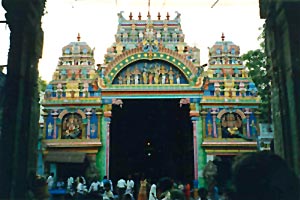 Madurai is known as temple town and it is one of the most ancient cities of India. In a way it truly reflects the cultural ethos of the place. Apart from the Meenakshi Temple, the heart of the city, there several shrines those are located within the vicinity of the town. Apart from being religiously significant the temples are excellent pieces of work. Intricately designed and carved out these are exquisitely beautiful.
Madurai is known as temple town and it is one of the most ancient cities of India. In a way it truly reflects the cultural ethos of the place. Apart from the Meenakshi Temple, the heart of the city, there several shrines those are located within the vicinity of the town. Apart from being religiously significant the temples are excellent pieces of work. Intricately designed and carved out these are exquisitely beautiful.
Temples around the town of Madurai are as follows
Coodal Azhagar Temple: To the west of Madurai temple is this ancient Vishnu shrine with beautiful sculptures. The Lord is seen in sitting, standing and reclining postures, each depicted one above the other in a three-tier form.
Azhagarcoil: It is located 20 kilometers away from Madurai. The Vishnu temple here is dedicated to Sundararajar or Kallazhagar. It is situated in the picturesque surroundings at the foot of Azhagar Hills. The presiding deity is also known as Paramaswamy. `Abhishekam` or the coronation of the Lord is performed only with water brought from Noopura Ganga, a sacred Teertha on the hills, since any other water, if used, will discolor the idol. The deities of Kalyana Sundaravalli Nachiyar, Andal, Sudarshana and Yoga Narasimha are in separate shrines.
Lord Karuppanna Swamy, guardian deity of the shrine and Goddess Rakhayi Ammai deserve special mention. A flight of 18 steps leads one to the main entrance to the Karuppanna Swamy shrine. Pujas are performed for these steps and the big wooden door.
The major festival takes place on Chitra Poornima day. Azhagar, the brother of Meenakshi, is taken in a procession to river Vaigai to participate in the Meenakshi-Sundareswarar wedding.
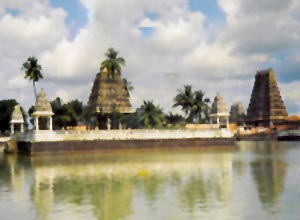 Pazhamudircholai: This is one of the six abodes (Arupadai Veedu) of Lord Subramanya. It is situated around 2 kilometers from Azhagarcoil on the hills.
Pazhamudircholai: This is one of the six abodes (Arupadai Veedu) of Lord Subramanya. It is situated around 2 kilometers from Azhagarcoil on the hills.
Thiruparankundram: Located 8 km away from Madurai this 6th century rock-cut temple is dedicated to Lord Subramanya. It is one of the six abodes (Arupadai Veedu) of the Lord. Here, Subramanya married Deivayanai, daughter of Indra, after the victory over Surapadman.
The main shrine is an early cave temple situated at a height of 1050 feet. There are 48 artistic pillars at the entrance of this shrine.
A seven-tier gopuram above the Kalyana Mandapam is a great piece of sculpture. In the sanctum, there are 5 cells, each enshrining a deity. In the central shrines Muruga, Durga and Vinayaka are worshipped.
A special feature of Vinayaka is that He is holding only fruits and sugarcane. Muruga is in sitting posture with Deivayanai. To Her right is sage Narada. Vinayaka. Brahma, Indra, Surya and Chandra are depicted above these images. In the two cells facing each other, there are images of Vishnu with Sridevi and Bhoodevi and a Lingam respectively.
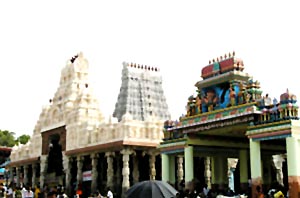 At the top of the hill, there is a shrine dedicated to Kasi Viswanatha. The image of Nakkeerar, the Tamil poet, is seen here standing in reverence.
At the top of the hill, there is a shrine dedicated to Kasi Viswanatha. The image of Nakkeerar, the Tamil poet, is seen here standing in reverence.
Thirumohur: Here is a Vishnu temple dedicated to Kaalamegha Perumal. In the shrine of Chakrathalwar, the deity is installed on a Peeta with Bhijakshara Mantra. This place is considered as holy as Naimisaranyam in North India. From Madurai the tourists need to travel 11 kilometers to reach this pilgrimage site.
Manamadurai: It is closely associated with Ramayana. Hanuman is said to have stopped over here with his brigade on his way to Lanka to rescue Sita from Ravana. In the Vishnu temple here, Hanuman is seen in an unusual form wearing a crown on his head. Legend has it that Hanuman was crowned here before he set out for Lanka. From Madurai it is 120 kms away.
Kalaiyarcoil: The Siva temple, 64 km from Madurai, is dedicated to Kaliswarar and His consort Swarnavalli. Following Lord Shiva`s curse, Goddess Parvati came here in the form of Kali to do penance. She annihilated Chandasura and regained Her original form. Shiva later married Her. There are also shrines for Komeswarar and Sundaresar.
Thiruvaadaanai (37 km from Devakottai): The red stone Vinayaka here was worshipped by Sri Rama during His banishment. Adi Sankara is said to have sung in praise of this Vinayaka in his Ganesha Pancha Ratna Mala.
According to a legend, sage Durvasa cursed Varuni, son of Varuna, to be metamorphosed into the body of an elephant with the head of a goat. Varuni did penance at the Adi Ratneswara temple here and regained his original form. Thus the origin of the name Thiruvaadaanai is related to this legend as `Thiru` means sacred; `Aadu` - goat and `Aanai` stands for an elephant.
Pillayarpatti: This village is located at a distance of 11 km from Karaikudi. This place derives its name from the image of Lord Ganesha, known as Karpaga Vinayaka. The image is carved on the wall of an ancient rock-cut temple.
 The Lord is seated and appears with only two arms. His left arm is on the waist and in the right hand He is holding a modaka. The trunk is turned to the right. There is no sacred thread on this Ganesha sculpture.
The Lord is seated and appears with only two arms. His left arm is on the waist and in the right hand He is holding a modaka. The trunk is turned to the right. There is no sacred thread on this Ganesha sculpture.
A few kilometers from here is Kundrakudi. This place is known for the temple of Muruga.
Thirukoshtiyur (10 km from Tirupattur): This is the birthplace of Nambi Andar, Guru of Sri Ramanuja. In the Vishnu temple the Lord is worshipped in four different postures in a four-tier structure.
Avudayarcoil: Located 180 km from Madurai and 15 km from Arantangi this place is known for Sri Atmanandaswamy temple. It is known for its exquisite sculptural work.
There is no Lingam in the sanctum. It contains only the base of the Lingam. Similarly, only a Sri Vidya Chakra represents the Goddess. It is said that the Lord gave darshan to Manickavasagar below the Kurunthai tree, the Sthala Vriksham.
The temple has numerous halls such as Panchakshara Mandapam, Natana Sabha and Deva Sabha. Each of these symbolise a different philosophy involving the worship of Shiva. The sanctum also has five Deepas representing five Kalas and 27 Deepas representing the 27 Nakshatras.
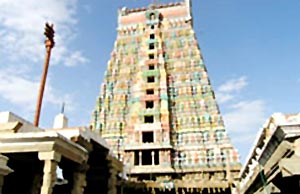 Srivilliputhur: This is the birthplace of Sri Andal, the Divine Child brought up by Vishnu Chittar (Periya Alwar). The girl, by her insatiable love for and true devotion to Lord Ranganatha, decided that she would marry only the Lord. At the bidding of Lord Ranganatha, Andal was taken to Srirangam in a palanquin in bridal pomp and glory. She was led into the sanctum, where she merged with the Lord. It is 80 km away from Madurai.
Srivilliputhur: This is the birthplace of Sri Andal, the Divine Child brought up by Vishnu Chittar (Periya Alwar). The girl, by her insatiable love for and true devotion to Lord Ranganatha, decided that she would marry only the Lord. At the bidding of Lord Ranganatha, Andal was taken to Srirangam in a palanquin in bridal pomp and glory. She was led into the sanctum, where she merged with the Lord. It is 80 km away from Madurai.
Hence the main attraction at Srivilliputhur is the shrine of Lord Ranganatha and Andal where their images are installed in bridal attire. Garuda Alwar is enshrined by the side of Sri Ranganatha.
Andal`s devotional Tamil songs, known as Thiruppavai, are as popular as Meera`s bhajans.
The shrines of Vatapatrasayee (Vishnu reclining on Adi Sesha), Navaneeta Krishna and Srinivasa Perumal in Srivilliputhur are noteworthy too.
The fifth day of Adi festival (July-Aug) and the sixth day of Margazhi festival (Dec-Jan) here attract thousands of pilgrims.
Kuchanoor: The temple here is dedicated to Saniswara, who is a Swayambu image. It is located near Theni. People throng this place on Saturdays. The annual festival in Adi and Shani Peyarchi attract lots of pilgrims.
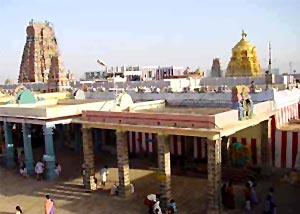 Palani: This hill temple, 125 kilometers from Madurai, is one of the six abodes (Arupadai Veedu) of Lord Muruga. In the sanctum, the Lord stands as an young ascetic holding a dhanda. Hence He is known as Bala Dhandayudhapani.
Palani: This hill temple, 125 kilometers from Madurai, is one of the six abodes (Arupadai Veedu) of Lord Muruga. In the sanctum, the Lord stands as an young ascetic holding a dhanda. Hence He is known as Bala Dhandayudhapani.
According to a legend, Muruga lost in a contest with His brother Vinayaka over a rare mango. He left Kailash in a huff and came down to this hill. Here, Lord Shiva pacified Him by saying that He Himself is the embodiment of Gyana (Knowledge). The Lord from then on came to be known as Palani Murugan or Palani Andavar.
There is another legend associated with Palani. The hills named Shaktigiri and Sivagiri were once carried on the shoulders by Idumban, the disciple of sage Agastya, at the Rishi`s bidding for his worship. On his way Idumban placed the hills here to take rest. But when he wanted to carry them again he could not lift them. To his surprise, Idumban noticed Muruga standing there, claiming Sivagiri to be His. This led to a clash between the two. Agastya intervened, pacified Muruga and worshipped the Lord there. Muruga blessed Idumban and gave him a permanent place in Shaktigiri. The popular Kavadi worship in this temple is in commemoration of this legend.
The deity of Muruga is said to have been created by Bhoga Siddhar, an ardent devotee, by using Navapashanam (an amalgam of nine poisonous minerals). The continuous process of `abhisheka` and `alankara` are noteworthy in the temple. The `abhishekaprasada` is said to have curative properties.
The festivals held at this temple include Thai Poosam held during January-Februaury, Panguni Uthiram (April-May) and Skanda Shashti (Nov-Dec) besides Karthigai and Shashti every month.





















